All changes in the shape and deformation of the fruiting bodies, which will be discussed below, are so ugly and clumsy that many mushroom growers seriously say that the oyster mushroom has mutated.
But oyster mushrooms do not have mutations, and they do not suffer from viral diseases that supposedly cause mutations.
This is all speculation.
In 2005, in a Russian-language magazine on mushroom growing there was an article about viruses. It said that two viruses had been isolated, due to which the drusen becomes shapeless and is not divided into individual mushrooms.
These were studies of just one case, and I don’t even know how scientifically sound this article is.
Probably one of the mushroom growers spread this article on the forums and this myth began that oyster mushrooms are susceptible to viral diseases.
Many people want to understand the reasons for their failures. However, they more easily perceive the fact that the reason is not in their microclimate, so the myth about the virus suits them quite well.
I explain that the reason for the shape of the oyster mushroom, as in the photo below, is the complete or partial absence of a ventilation system.
Which reason will you believe - a virus or climate error - choose for yourself)
Producers of grain spawn must provide a passport containing the optimal climate parameters for each strain.
If you do not comply with these parameters, or the fan and humidifier operate on a timer, the more bizarre and incomprehensible the shape of the cap and stem will be.
And the more difficult it is to figure out what caused this curvature.
Let's consider the causes of spikes on oyster mushrooms, bumpy formations, waviness and various growths on mushroom caps.
Own moisture will slowly evaporate from the fruiting body due to excessive moisture and low temperature in the growing room, if the air ducts are made incorrectly and/or if there is insufficient airflow near the mushroom clusters themselves.
The oyster mushroom fruiting body tries to increase the evaporation surface through growths and/or by thickening the stem.
In this case, the leg grows, protruding the gills (lamellae) outward; it can be hollow or loose.
Outwardly it resembles a barrel.
The thick leg in this case has a normally developed cap.
If you press on the leg with your fingers, water comes out.
Check the air flow speed, it may have become lower than usual for some reason. The recommended speed is from 8 to 11 m/sec, depending on the location of the ventilation system, the method of arranging the blocks and the mass of fruiting in the growing chamber.
If such mushrooms grow constantly, it is necessary to properly plan and reinstall the microclimate systems in the chamber.
If you can't maintain the optimal temperature for a given strain in winter, the humidity won't be optimal either.
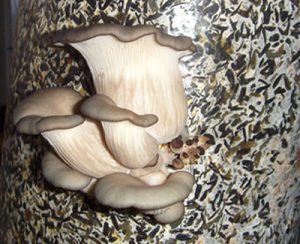
At low temperatures in the chamber, a whole range of factors influence the mushrooms. Many mushroom growers, in order to save money, close the fresh air damper to a minimum.
Or they turn off the ventilation altogether at night.
As a result, they have crooked, concave and wavy oyster mushrooms.
A long thickened leg, a cap that is corrugated and rolled inward (similar to a gramophone), as in the photo.
In this case, it is necessary to gradually, over the course of two days, increase the temperature by 3-4 degrees, without reducing the humidity.
If it is not possible to increase the temperature, it is necessary to reduce the humidity to 82% - as a temporary measure. But at the first opportunity you need to start increasing both the humidity and temperature. At least up to 11 degrees and 84-85%. But, you must remember that it is better to take the optimal humidity in the strain passport. Some strains grow better in lower humidity than I wrote.
If the temperature in the chamber is low and the level of CO2 is high, white growths are formed, similar to semolina, or a mesh on the cap - picture on the right.
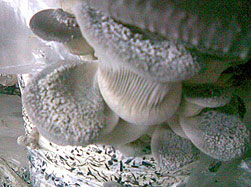
This white semolina, similar to skin outgrowths, is most likely the so-called secondary mycelium - the mycelium, under unfavorable conditions, forms the rudiments of fruiting bodies.
These mushrooms can be eaten. But you are unlikely to be able to convince the buyer that everything is fine with them.
Warts along the edge of the cap, which look like pimples or bumps, occur with a significant, 3-5% increase in humidity, with a simultaneous increase in CO2 concentration.
This happens if on a frosty night the operator closes the fresh air damper by a large percentage at once.
The humidity nozzles continue to operate and the humidity increases.
Small mushrooms form warts on the skin, which become visible only after a day or two.
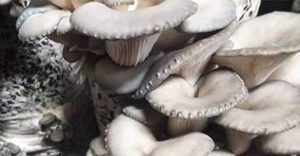
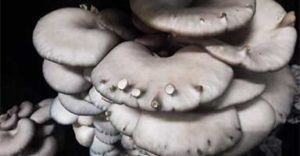
Then you get an oyster mushroom cap with warts on the edges. At the same time, the mushroom loses its presentation.
In winter, the outside air contains little moisture.
Therefore, when working with large volumes of fresh air and a small percentage of recirculation, the following paradox arises:
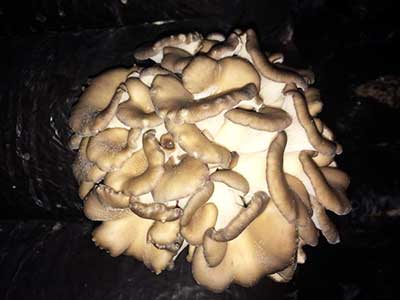
The humidification nozzles are working at full power, but the humidity is still low.
This happens because the air flow does not have time to absorb moisture, since the flow speed is high and the period of interaction with the nozzles is short.
Therefore, many people decide to install nozzles on the ceiling in the chamber.
If you turn them on periodically, it doesn’t matter whether it’s from a timer or a humidity sensor, a wavy edge will form on the oyster mushroom, and often the entire mushroom will become wavy. Some mushroom growers say that the mushrooms have become curly.
Particularly bizarre curliness occurs if the air in the air ducts is not humidified at all - and a dry stream comes out of them, warmer than in the chamber.
On the cap of such oyster mushrooms, scales are often visible, as in this photo - these are dead exfoliated skin cells.
First of all, check the ventilation.
You won't be able to save heat by turning off the ventilation or setting it to full recirculation - this is how pimples and growths most often appear on the skin.
This misconception will cost much more than the savings itself - you are unlikely to be able to sell such mushrooms with warts.
Oyster mushrooms can also grow at low temperatures (especially winter strains). At +5-8 degrees in the growing room, less CO2 is released, since mushroom clusters grow slowly.
But, she still needs fresh air and flows passing directly around the primordia
Therefore, ventilation must work, and the percentage of fresh air can be reduced to a minimum while the mushrooms are still marketable.
